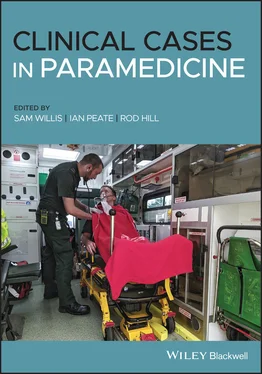3 Which groups are most at risk of developing sepsis? Elderly patients (>75 years or frail).Young patients (under 1 year).Immunocompromised patients whose immune system is impaired by medication or illness (e.g. chemotherapy patients) or where immune function is impaired due to medical conditions (diabetes and sickle cell) or medications (immunosuppressants or steroids).Post‐surgery (within the last 6 weeks).Open wounds.Patients with indwelling medical devices (catheters or cannulas).Intravenous drug users.Pregnant women with recent history of miscarriage or termination and post‐delivery.
4 What prompts or tools are used to determine when to screen for sepsis? Guidelines used to recommend use of the modified systemic inflammatory response syndrome (SIRS) criteria, whereby patients presenting with two of more SIRS criteria with a confirmed or suspected infection were deemed to require further investigation to confirm or exclude a diagnosis of sepsis. This screening tool captured those patients presenting with ‘uncomplicated’ sepsis who were otherwise well and were at low risk for clinical deterioration. The definition of sepsis has now been updated so only those with a degree of organ dysfunction or clinical compromise are included. The SIRS criteria are no longer used as a screening tool.The red flag system was developed to be used in conjunction with the SIRS criteria as a guide to which patients needed early intervention. This was to ensure responsible antibiotic stewardship due to the sensitivity of the SIRS criteria. The red flag system is quick to apply and is used by over 90% of UK hospitals.The revised version of the National Early Warning Score (NEWS2) track and trigger system has been shown to be the most effective screening tool for predicting adverse outcomes for patients presenting with sepsis. This has now been incorporated into many systems, where screening is recommended for those with a NEWS2 of greater than 5 with identified risk factors or clinician concerns.
5 Which components of the Sepsis Six apply to the prehospital environment? Oxygen: titrate to maintain SpO2 at 94–98%.Fluids: bolus of 500 mL over 15 minutes if indicated (systolic BP <90 mmHg).Antibiotics: benzylpenicillin for meningococcal septicaemia. Refer to local guidelines regarding the use of broad‐spectrum antibiotics. Not routinely recommended.Lactate: measure lactate if indicated by local guidelines. Not routinely recommended.
LEVEL 3 CASE STUDY
Smoke inhalation
| Information type |
Data |
| Time of origin |
02:24 |
| Time of dispatch |
02:25 |
| On‐scene time |
02:30 |
| Day of the week |
Friday |
| Nearest hospital |
15 minutes |
| Nearest backup |
10 minutes |
| Patient details |
Name: Sam Bryant DOB: 09/09/1990 |
You have been called to a fire at a residential address for a 30‐year‐old male with smoke inhalation.
The patient is conscious and breathing and has extricated himself from the fire. He is at the neighbour’s house when you arrive.
Fire and police units are on scene. The incident has been contained.
The patient is sat on the couch at a neighbour’s house.
On arrival with the patient
The patient is talking to a police officer and appears distressed.
Patient assessment triangle
General appearance
He is alert and has soot around his mouth and nose. He is coughing quite badly.
Normal skin colour.
Increased work of breathing.
SYSTEMATIC APPROACH
Danger
None at this time – the hazard has been contained.
Alert on the AVPU scale.
Clear. Soot is noted in the mouth and nose. Singed nasal hairs and hoarse voice.
RR: 28. No accessory muscle use. Equal air entry in both lungs, no adventitious (added) sounds on auscultation.
HR: 106. The radial pulse is palpable – regular. Capillary refill time 1 second.
Pupils equal and reactive to light (PEARL), 4 mm.
The chest is exposed in a private dwelling to undertake a physical exam – the ambient temperature is warm.
RR: 28 bpm
HR: 106 bpm
BP: 125/82 mmHg
SpO 2: 97%
Blood glucose: 5.1 mmol/L
Temperature: 36.6 °C
GCS: 15/15
4 lead ECG: sinus tachycardia
Look through the information provided in this case study and highlight all of the information that might concern you as a paramedic.
En route to hospital, the patient starts to become lethargic and complains of a headache and dizziness. On checking the patients carbon monoxide (CO) level, you notice it is much higher than expected. You administer high‐flow oxygen through a non‐rebreathe mask using 15 L of oxygen and transport the patient to the nearest Emergency Department with a pre‐alert call due to the smoke inhalation and potential for CO poisoning.
Patient assessment triangle
General appearance
Alert but no longer meeting gaze.
Normal.
Increased work of breathing – but improved since treatment provided.
SYSTEMATIC APPROACH
Danger
None at this time.
Alert but becoming lethargic.
Clear.
RR: 28. Wheeze resolving following interventions.
HR: 128. Palpable radial. Capillary refill time 1 second.
Moving all four limbs.
Normal temperature in the ambulance.
RR: 28 bpm
HR: 128 bpm
BP: 130/78 mmHg
SpO 2: 97%
CO: 25 ppm
Blood glucose: not repeated
Temperature: not repeated
GCS: E3, V6, M5, 14/15
4 lead ECG: sinus tachycardia
1 Explain the significance of the soot in and around the mouth and nose. Soot in mouth and nose is suggestive of inhalation injury. The patient also has singed nasal hair and a hoarse voice, so there is the potential for airway burns that may lead to further complications as the airway starts to swell. The cough indicates the patient may have inhaled irritants, so be aware for signs of toxicity as well. Inhalation injury is the main cause of mortality in burn patients.
2 Why might SpO 2 monitoring be unreliable in this patient? What else could you measure?Pulse oximetry measures peripheral capillary oxygen saturation (SpO2) and the percentage of haemoglobin (oxygenated haemoglobin) compared to the total amount of haemoglobin. Carbon monoxide is one of the products of combustion and can affect patients exposed to smoke‐filled environments. CO diffuses across the alveoli in a similar way to oxygen, creating carboxyhaemoglobin, which has a much greater affinity with haemoglobin than oxygen (approx. 250 times greater). This reduces the ability of the haemoglobin to transport oxygen around the body. Pulse oximetry cannot distinguish between oxyhaemoglobin and carboxyhaemoglobin and SpO2 readings may be falsely elevated, making it challenging to accurately determine the severity of the patient. Some non‐invasive pulse oximetry devices can measure carboxyhaemoglobin saturation (SpCO) levels, although most are not validated and should be used as an adjunct to clinical decision making.End‐tidal carbon dioxide (EtCO2) would be another useful addition, as it would help detect any bronchospasm that may not be noted on auscultation.
Читать дальше












